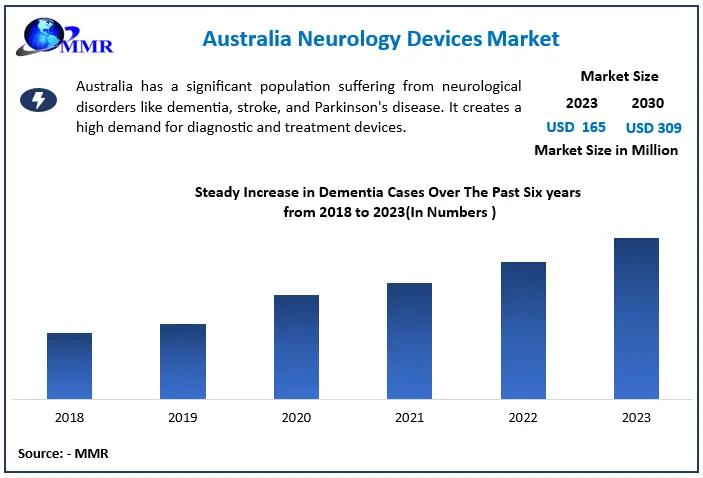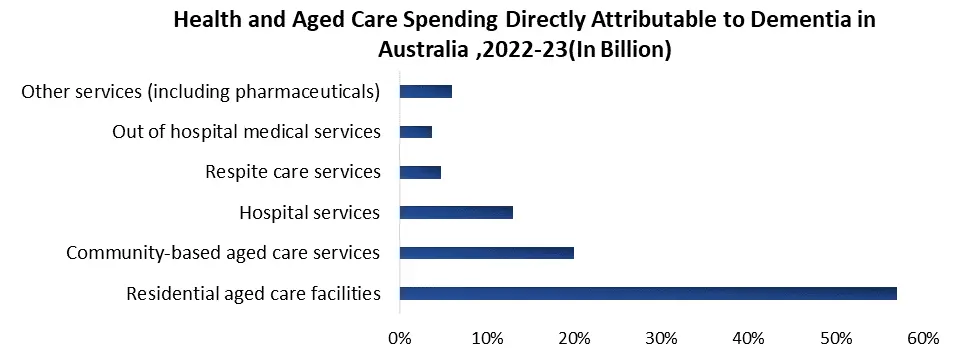The Australia Neurology Devices Market size was valued at USD 165 million in 2023. The total Australia Neurology Devices Market revenue is expected to grow at a CAGR of 9.4% from 2023 to 2030, reaching nearly USD 309 Million.Australia Neurology Devices Market Analysis
The MMR comprehensive report provides the Current Market Trends, Regulatory Landscape, and Technological advancements, offering through examination of key players and their market strategies. The analysis Focuses on Growth opportunities, potential Challenges, and the impact of including healthcare policies in Australia. In Addition, the Report covers the emerging technologies, innovations, and their implications for the neurology devices market in Australia. Early-stage companies developing novel neuromodulation and BCI technologies present high-risk and high-reward opportunities. Startup businesses creating innovative Brain-Computer (BCI) and neuromodulation technology offer high-risk, high-reward possibilities. More reliable investments are provided by established Deep Brain Stimulation (DBS) players, who are also expected to create profit from rising market demand. Investigating innovative developments in neurology, potential investments include brain-computer interfaces, neuromodulation, and deep brain stimulation equipment. To give neurological patients remote care, telemedicine, and remote monitoring include both software and hardware solutions. It offers profitable investment opportunities. Personalized medical projects present promising investment opportunities as well, as they customize diagnoses and therapies to the specific needs of each patient.1. About 600,000 Australians suffer from neurological disorders, which makes it a serious healthcare issue. A majority of Australians, above 50%, prefer virtual consultations while managing chronic diseases, showing a changing healthcare landscape. The Australian government's Significant investment of 250 million in customized medicine research serves as further evidence of its commitment to advancing healthcare solutions.
To know about the Research Methodology :- Request Free Sample Report The Rise of Minimal Invasive in Neurology In neurology, there is an increasing trend toward less invasive procedures, which is resulting in the creation and use of devices that provide less invasive treatment choices with shorter recovery times. Compared to open surgeries, minimally invasive procedures (MIPs) are linked to fewer risks and problems, including less bleeding, shorter hospital stays, quicker recovery times, and decreased infection risks. These techniques improve patient comfort and general quality of life in addition to producing clinical outcomes that are comparable to or better than before. MIPs are expected to have a huge influence in 2023, altering surgical techniques and enhancing patient outcomes. The Impact of Limited Domestic Manufacturing on the Australian Neurology Devices Market Australia's dependence on imported neurological equipment has significant implications for the sector, affecting its potential for growth as well as stability. Strong domestic demand for neurology equipment creates jobs in the engineering, R&D, and manufacturing industries, as well as in specialized roles. It Promotes an environment of creativity and cooperation in addition to supporting economic progress. Australian companies and researchers customize their neurological products to meet the specific requirements of the home market thanks to local production.• In 2023, the average cost of a brain tumor device in Australia was 25% higher than in the US, partly due to factors such as import costs and lack of price competition from domestic manufacturers.
Australia Neurology Devices Market Segment Analysis
By end user, Hospitals and Clinics hold the dominant share of the Australian o Neurology Devices market, estimated at around 55%. Many hospitals are investing in dedicated neurology departments and acquiring advanced technology to provide the growing demand. It is expected to decrease the dependence on specialty centers for certain procedures. As advanced technologies become user-friendly and cost-effective, they gradually transition from specialty centers to wider hospital use. It is expected to Increase new opportunities for segment growth and wider patient access to innovative treatments.Australia Neurology Devices Market Scope: Inquiry Before Buying
Australia Neurology Devices Market Report Coverage Details Base Year: 2023 Forecast Period: 2024-2030 Historical Data: 2018 to 2023 Market Size in 2023: US $ 165 Mn. Forecast Period 2024 to 2030 CAGR: 9.4% Market Size in 2030: US $ 309 Mn. Segments Covered: by Product Type Deep Brain Stimulation Devices Sacral Nerve Stimulation Vagus Nerve Stimulation Interventional Neurology CSF Management Neurosurgery Devices Neurostimulation Spinal Cord Stimulation Devices Gastric Electric Stimulation by End User Specialty Centres Hospitals and Clinics Key Players in the Australia Neurology Devices Market
1. BHP Group 2. Rio Tinto 3. Commonwealth Bank of Australia 4. Westpac Banking Corporation 5. Australia and New Zealand Banking Group 6. Telstra 7. Woodside Petroleum 8. National Australia Bank 9. Santos Ltd. 10. Wesfarmers Limited 11. Anatomics Pty Ltd 12. Penumbra, Inc 13. Neurostim Australia 14. Genetic Technologies Limited 15. Nextgen Medical Products Pty LtdFAQs:
1. What are the key drivers in the Australian Neurology Devices Market? Ans The increasing prevalence of neurological disorders, including epilepsy, Alzheimer's disease, and Parkinson's disease, is expected to drive the demand for neurology devices in Australia. 2. Which neurological conditions are most addressed by these devices? Ans. Devices such as neurostimulators are expected to be used to manage epilepsy by delivering electrical impulses to specific brain areas to control seizures. 3. What is the projected market size & and growth rate of the Australian Neurology Devices Market? Ans. The Australia Neurology Devices Market size was valued at USD 165 million in 2023. The total Australian Neurology Devices market revenue is expected to grow at a CAGR of 9.4% from 2023 to 2030, reaching nearly USD 309 Million By 2030.
1. Australia Neurology Devices Market Introduction 1.1. Study Assumption and Market Definition 1.2. Scope of the Study 1.3. Executive Summary 2. Australia Neurology Devices Market: Dynamics 2.1. Australia Neurology Devices Market Trends 2.2. PORTER’s Five Forces Analysis 2.3. PESTLE Analysis 2.4. Value Chain Analysis 2.5. Regulatory Landscape of Australia Neurology Devices Market 2.6. Technological Advancements in the Australian Neurology Devices Market 2.7. Factors Driving the Growth of the Neurology Devices Market in Australia 2.8. Technological Advancements in Oncology 2.9. Government Policies Reform for the Healthcare Sector in Australia 2.10. How Much Australians Suffer from Neurological Disorder 2.11. Australia's Annual Expenditure on Pharmaceuticals 2.12. Dementia cases in Australia from the last six years 2.13. Health and Age Care Spending in Australia in 2022- 2023 2.14. Key Opinion Leader Analysis for the Australian Neurology Devices Industry 2.15. Australia Neurology Devices Market Price Trend Analysis (2022-23) 3. Australia Neurology Devices Market: Market Size and Forecast by Segmentation for (by Value in USD Million) (2023-2030) 3.1. Australia Neurology Devices Market Size and Forecast, by Product Type (2023-2030) 3.1.1. Deep Brain Stimulation Devices 3.1.2. Sacral Nerve Stimulation 3.1.3. Vagus Nerve Stimulation 3.1.4. Interventional Neurology 3.1.5. CSF Management 3.1.6. Neurosurgery Devices 3.1.7. Neurostimulation 3.1.8. Spinal Cord Stimulation Devices 3.1.9. Gastric Electric Stimulation 3.2. Australia Neurology Devices Market Size and Forecast, by End User (2023-2030) 3.2.1. Specialty Centres 3.2.2. Hospitals and Clinics 4. Australia Neurology Devices Market: Competitive Landscape 4.1. MMR Competition Matrix 4.2. Competitive Landscape 4.3. Key Players Benchmarking 4.3.1. Company Name 4.3.2. Product Segment 4.3.3. End-user Segment 4.3.4. Revenue (2023) 4.4. Market Analysis by Organized Players vs. Unorganized Players 4.4.1. Organized Players 4.4.2. Unorganized Players 4.5. Leading Australia Neurology Devices Market Companies, by market capitalization 4.6. Market Trends and Challenges in China 4.6.1. Technological Advancements 4.6.2. Affordability and Accessibility 4.6.3. Shortage of Skilled Professionals 4.7. Market Structure 4.7.1. Market Leaders 4.7.2. Market Followers 4.7.3. Emerging Players in the Market 4.7.4. Challenges 4.7.5. Mergers and Acquisitions Details 5. Company Profile: Key Players 5.1. BHP Group 5.1.1. Company Overview 5.1.2. Business Portfolio 5.1.3. Financial Overview 5.1.4. SWOT Analysis 5.1.5. Strategic Analysis 5.1.6. Details on Partnership 5.1.7. Potential Impact of Emerging Technologies 5.1.8. Regulatory Accreditations and Certifications Received by Them 5.1.9. Strategies Adopted by Key Players 5.1.10. Recent Developments 5.2. Rio Tinto 5.3. Commonwealth Bank of Australia 5.4. Westpac Banking Corporation 5.5. Australia and New Zealand Banking Group 5.6. Telstra 5.7. Woodside Petroleum 5.8. National Australia Bank 5.9. Santos Ltd. 5.10. Wesfarmers Limited 5.11. Anatomics Pty Ltd 5.12. Penumbra, Inc 5.13. Neurostim Australia 5.14. Genetic Technologies Limited 5.15. Nextgen Medical Products Pty Ltd 6. Key Findings 7. Industry Recommendations 8. Australia Neurology Devices Market: Research Methodology

